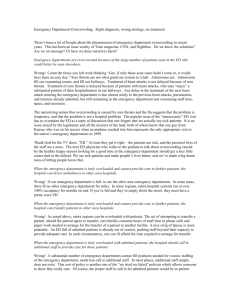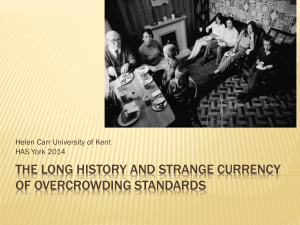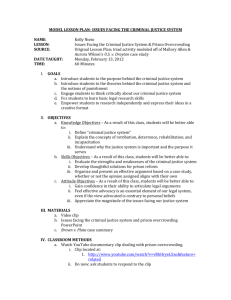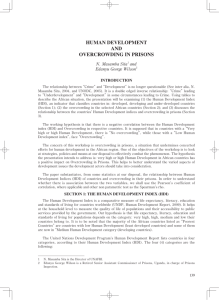The impact of emergency department overcrowding on ED length of
advertisement
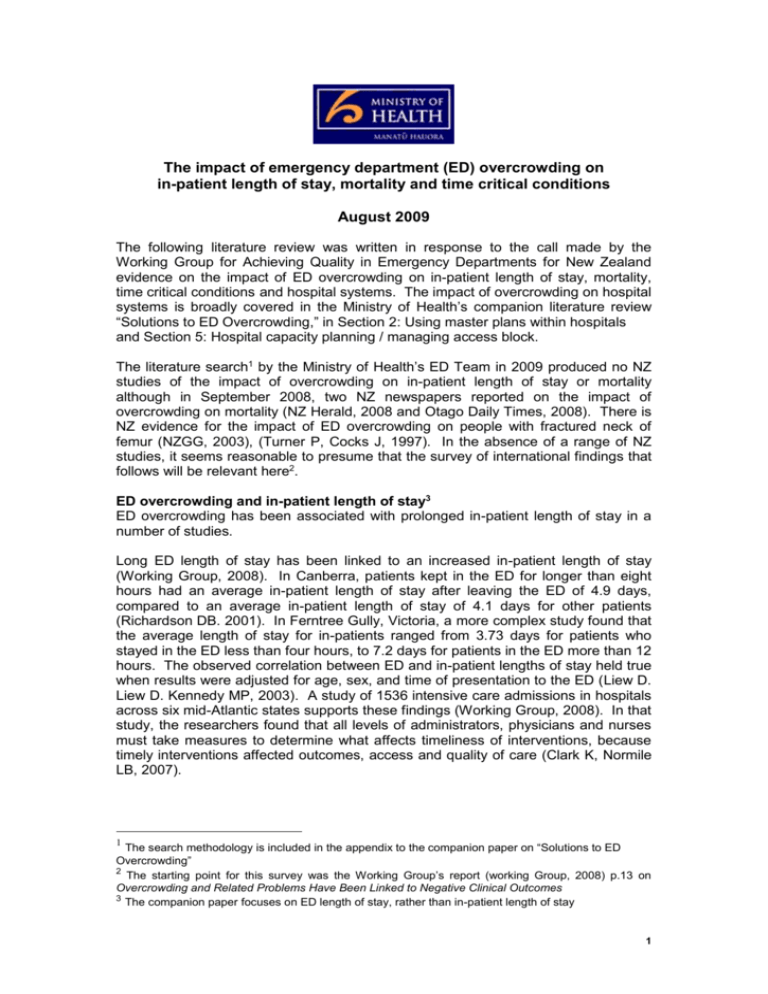
The impact of emergency department (ED) overcrowding on in-patient length of stay, mortality and time critical conditions August 2009 The following literature review was written in response to the call made by the Working Group for Achieving Quality in Emergency Departments for New Zealand evidence on the impact of ED overcrowding on in-patient length of stay, mortality, time critical conditions and hospital systems. The impact of overcrowding on hospital systems is broadly covered in the Ministry of Health’s companion literature review “Solutions to ED Overcrowding,” in Section 2: Using master plans within hospitals and Section 5: Hospital capacity planning / managing access block. The literature search1 by the Ministry of Health’s ED Team in 2009 produced no NZ studies of the impact of overcrowding on in-patient length of stay or mortality although in September 2008, two NZ newspapers reported on the impact of overcrowding on mortality (NZ Herald, 2008 and Otago Daily Times, 2008). There is NZ evidence for the impact of ED overcrowding on people with fractured neck of femur (NZGG, 2003), (Turner P, Cocks J, 1997). In the absence of a range of NZ studies, it seems reasonable to presume that the survey of international findings that follows will be relevant here2. ED overcrowding and in-patient length of stay3 ED overcrowding has been associated with prolonged in-patient length of stay in a number of studies. Long ED length of stay has been linked to an increased in-patient length of stay (Working Group, 2008). In Canberra, patients kept in the ED for longer than eight hours had an average in-patient length of stay after leaving the ED of 4.9 days, compared to an average in-patient length of stay of 4.1 days for other patients (Richardson DB. 2001). In Ferntree Gully, Victoria, a more complex study found that the average length of stay for in-patients ranged from 3.73 days for patients who stayed in the ED less than four hours, to 7.2 days for patients in the ED more than 12 hours. The observed correlation between ED and in-patient lengths of stay held true when results were adjusted for age, sex, and time of presentation to the ED (Liew D. Liew D. Kennedy MP, 2003). A study of 1536 intensive care admissions in hospitals across six mid-Atlantic states supports these findings (Working Group, 2008). In that study, the researchers found that all levels of administrators, physicians and nurses must take measures to determine what affects timeliness of interventions, because timely interventions affected outcomes, access and quality of care (Clark K, Normile LB, 2007). 1 The search methodology is included in the appendix to the companion paper on “Solutions to ED Overcrowding” 2 The starting point for this survey was the Working Group’s report (working Group, 2008) p.13 on Overcrowding and Related Problems Have Been Linked to Negative Clinical Outcomes 3 The companion paper focuses on ED length of stay, rather than in-patient length of stay 1 ED overcrowding and mortality Two Australian studies link ED overcrowding with increased mortality. 1. In Perth, 62,495 ED admissions and death records were the subject of a retrospective study that found that there is an association between hospital and ED overcrowding and increased mortality. This association was made explicit by the use of an Overcrowding Hazard Scale. The Scale was based on both hospital occupancy and percentage of patients in the ED who were waiting for an in-patient bed in Perth hospitals. The researchers found that where hospital bed occupancy was above 90 percent and 10-19 percent of ED beds contained patients waiting for an in-patient bed, or with a similar combinations of factors giving high hazard score ratings, 2.3 additional deaths would be seen per 1,000 new patients at day 30. Overcrowding in Perth hospitals was estimated to cause 120 deaths amongst 53,025 tertiary hospital presentations during 2003 (Sprivulis PC, Da Silva J-A, et al 2006). 2. In Canberra, in a study of 34,377 overcrowded and 32,231 not overcrowded presentations, there was a higher mortality rate by triage status in a study of 10 days mortality and overcrowding. Presentation during high ED occupancy was associated with approximately one third increased in-hospital mortality at 10 days, after controlling for seasonal, shift, and day of the week effects. The magnitude of the effect is about 13 deaths per year (Richardson DB, 2006). The Otago Daily Times and the NZ Herald reported on 8 September 2008 that “A shortage of hospital beds is killing as many as the national road toll of about 400..…Emergency doctors are calling for a 15% increase in the number of beds to help solve the problem, following research that indicates hundreds die every year…..An international review of studies on EDs, done for the (Australasian College for Emergency Medicine) finds that overcrowding and blocked access increase the risk of death 10 days later by 34%.....The review …..calculates the excess death toll in Australia is similar to the annual road toll of about 1500…..Dr Tim Parke, clinical director of Auckland City Hospital’s adults’ emergency department, said yesterday the number of deaths in New Zealand probably matched its road toll too.…..Overcrowded emergency departments lead to worse outcomes because of factors like delays in starting antibiotics for pneumonia, delayed heart-attack care and patients simply being overlooked because they are on a trolley in a corridor” (NZ Herald, 2008 and Otago Daily Times, 2008)4. Time-critical conditions ED overcrowding causes delays to treatment and this can be detrimental for patients with certain time-critical conditions (Duke G. Green J, Briedis J, 2004). A relationship between time to treatment and clinical outcomes has been demonstrated for patients with: stroke (Tilley BC, Lyden PD, et al, 1997), (Wester P, Radberg J et al 1999) acute myocardial infarction (Maynard C, Weaver WD, 1995), (Heath SM, Bain RJI, et al 2003) (Diercks DB, Roe MT, et al, 2007) (Chan PS, Krumholz HM, 2008) fractured neck of femur (NZGG, 2003), (Turner P, Cocks J, 1997) compound/open and long bone fractures (Stewart DGJr, Kay RM, Skaggs DL, 2005) sepsis, pneumonia and meningitis (International Sepsis Collaborative) 4 Debate ensued in Parliament between Hons Tony Ryall and Jim Anderton on the overcrowding issue (They Work For You, 2008). 2 penetrating trauma and major head injury (Brain Trauma Foundation) pneumonia in blunt trauma (Carr BG, Kaye AJ, et al, 2007) critical illness (Chalfin DB, Trzeciak S, et al, 2007). ______________________________________________________________ References Brain Trauma Foundation, URL: http://www.braintrauma.org/site/DocServer/Copy_of_Surgical_Guidelines_article_2.p df?docID=143. (Accessed April 2009. Login required) Carr BG, Kaye AJ, Wiebe DJ, Gracias VH et al (2007) Emergency department length of stay: a major risk factor for pneumonia in intubated blunt trauma patients J.Trauma 63:9 Chalfin DB, Trzeciak S, Likourezos A, Baumann BM et al (2007) Impact of delayed transfer of critically ill patients from the emergency department to the intensive care unit. Crit Care Med 35:1477 Chan PS, Krumholz HM, Nichol G, Nallamothy BK, Mancini M, Berg R, Peberdy MA, Allen E, Braithwaite S, Gosbee J, Hunt E, Larkin GL, Mears G, Nadkarni V, Truitt T, Potts J, Abella B, Geocadin R, Kern K, Eigel B, Ornato J (2008) Delayed Time to Defibrilation after In-Hospital Cardiac Arrest, N Engl J Med 358:9 Clark K, Normile LB (2007) Patient Flow in the Emergency Department: Is Timeliness to Events Related to Length of Hospital Stay? J Nurs Care Qual, 22(1):85 Diercks DB, Roe MT, Chen AY, Peacock WF et al (2007) Prolonged emergency department stays on non-ST-segment elevation myocardial infarction patients are associated with worse adherence to the American College of Cardiology/American Heart association guidelines for management and increased adverse events. Ann Emerg Med 50: 489) Duke G, Green J, Briedis J (2004) Survival of Critically Ill Medical Patients is TimeCritical, Critical Care and Resuscitation 6:261 Heath SM, Bain RJI, Andrews A, Chida S, Kitchen SI, Walters MI (2003) Nurse initiated thrombolysis in the accident and emergency department: safe, accurate, and faster than fast track, Emerg Med J 20:418 International Sepsis Collaborative, URL: http://www.survivingsepsis.org/6hr_bundles (accessed April 2009) Liew D, Liew D, Kennedy M P (2003) Emergency department length of stay independently predicts excess inpatient length of stay MJA 179:524 Maynard C, Weaver WD (1995) Streamlining the triage system for acute myocardial infarction, Cardiology Clinics 13(3):311 New Zealand Guidelines Group (2003) Acute management and immediate rehabilitation after hip fracture amongst people aged 65 years and over www.cebp.nl/media/m19.pdf NZ Herald (8 Sept 2008) 3 http://www.nzherald.co.nz/nz/news/article.cfm?c_id=1&objectid=10531020 Otago Daily Times (8 Sept 2008) http://www.odt.co.nz/news/national/21330/overcrowding-killing-patients Richardson DB (2001) The access-block effect: relationship between delay to reaching an inpatient bed and inpatient length of stay MJA 177:492 Richardson DB (2006) Increase in patient mortality at 10 days associated with emergency department overcrowding Med J Aust 184 (5):213 Sprivulis PC, Da Silva J-A, Jacobs IG, Frazer ARL, Jelinek GA (2006) The Association between hospital overcrowding and mortality among patients admitted via Western Australian emergency departments MJA 184 (5): 208 http://www.mja.com.au/public/issues/184_05_060306/spr10395_fm.html (accessed April 2009) Stewart DG Jr, Kay RM, Skaggs DL (2005) Open Fractures In Children – Principles of Evaluation and Management Journal of Bone and Joint Surgery 87-A:12. They work for you (2008) http://theyworkforyou.co.nz/portfolios/health/2008/sep/10/emergency_departments Tilley BC, Lyden PD, Brott TG, Lu M, Levine SR, Welch KMA (1997) Total Quality Improvement Method for Reduction of Delays Between Emergency Department Admission and Treatment of Acute Ischemic Stroke, Arch Neurol 54:1466 Turner P, Cocks J, Cade R, Ewing H, Collopy B, Thompson G (1997) Fractured neck of femur (DRG 210/211): prospective outcome study Australian and New Zealand Journal of Surgery 67:126 Wester P, Radberg J, Lundgren B, Peltonen M (1999) Factors Associated With Delayed Admission to Hospital and In-Hospital Delays in Acute Stroke and TIA, Stroke 30:40 Working Group for Achieving Quality in Emergency Departments (2008) Recommendations to Improve quality and the Measurement of Quality in New Zealand Emergency Departments Wellington: Ministry of Health http://www.moh.govt.nz 4


